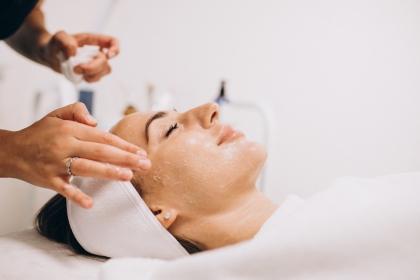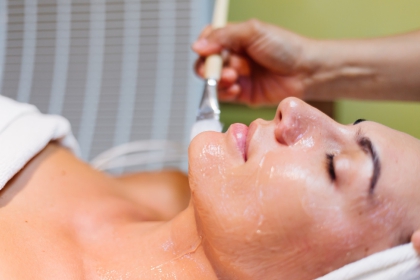A chemical peel is a technique used to improve & smooth the texture of skin, facial skin is mostly treated & scarring can be improved. chemical peels are intended to remove the outerm layers of the skin. Resulting wound heading process begin to regenerate new tissues. The dead skin evenlly peels off. The regenerated skin is usually smooth & less wrinkled than old skin.


Carboxylic acids such as glycolic acid & lactic. This is the mildest of the peel for treatment of wet areas& dryness, uneven skin tone, pigmentation acne.
Salicylic acid is a beta Hydroxy acid. salic acid has the ability to reduce the spots & bumps associated acne. The chemical peel improves skin texture, tone, and production of collar induction
Chemical peeling is a highly effective skin treatment designed to rejuvenate and revitalize your skin. By applying a specialized chemical solution, this procedure removes the damaged outer layers of skin to reveal a smoother, more radiant complexion beneath. Suitable for addressing a range of skin concerns, from fine lines and wrinkles to acne scars and sun damage, chemical peels offer a customizable approach to achieving clearer, more youthful- looking skin.
Chemical peels work by exfoliating the outermost layers of your skin using a chemical solution tailored to your specific skin type and concerns. During the procedure, the solution induces controlled damage to the skin, prompting the natural healing process and stimulating the production of new skin cells and collagen. As the old skin peels away, the fresh, new skin that emerges is typically smoother, more even in tone, and visibly rejuvenated.
Chemical peels offer numerous benefits for a variety of skin issues. They can effectively reduce the appearance of fine lines and wrinkles, diminish acne scars, improve skin texture, and even out pigmentation. Regular treatments can also enhance your overall skin tone and brightness, giving you a more youthful and vibrant appearance. Additionally, chemical peels can stimulate collagen production, which helps maintain skin elasticity and firmness over time.
The chemical peel procedure begins with a thorough cleansing of your skin to remove any impurities. The chosen chemical solution is then carefully applied to your skin, where it will remain for a specified period to achieve the desired depth of peel. During this time, you may experience a mild tingling or stinging sensation. Once the solution has effectively exfoliated the skin, it will be neutralized and removed. Post-treatment, your skin may be slightly red and sensitive, similar to a mild sunburn.
Proper aftercare is crucial to achieving the best results from your chemical peel. It's essential to keep your skin moisturized and protected from the sun using a high-SPF sunscreen. Avoid picking at any peeling skin to prevent scarring, and follow any additional skincare instructions provided by your dermatologist. With the right care, you'll soon enjoy the full benefits of your rejuvenated skin.
Chemical peels can be customized to meet a wide range of skin concerns and goals, making them suitable for many individuals. Ideal candidates are those looking to address issues such as fine lines, wrinkles, acne scars, hyperpigmentation, and sun damage. During your consultation, our experienced dermatologists will assess your skin and recommend the most appropriate type of peel to achieve your desired results.
For even more dramatic results, chemical peels can be combined with other skin treatments such as microdermabrasion, laser therapy, or injectable fillers. This integrated approach can help address multiple skin concerns simultaneously, providing a comprehensive rejuvenation plan tailored to your specific needs. Consult with our team to create a personalized chemical peel treatment plan that combines the best of what modern skincare has to offer.
Experience the transformative effects of chemical peel treatments at Shivsai clinic, located in Kolhapur. Whether you’re seeking to reduce the signs of aging, diminish acne scars, or simply achieve a brighter complexion, our skilled dermatologists are here to help you achieve your skincare goals. Schedule a consultation today with Dr. Priyanka Kawale, best dermatologist in Kolhapur to learn more about how chemical peels can benefit your skin and enhance your natural beauty.
Our other skin treatments are Permanent Makeup Treatments, PRP, Oxygen Facial, Hydra Facial, Derma Rollers, E Facial, Under Eye Treatments etc. So we are providing best skin treatments in Kolhapur for all types of skin problems. Book your visit today.
Schedule a consultation today with Dr. Priyanka Kawale, best dermatologist in Kolhapur for best skin treatments in kolhapur, best hair treatments in kolhapur & best laser treatments in kolhapur and enhance your natural beauty.